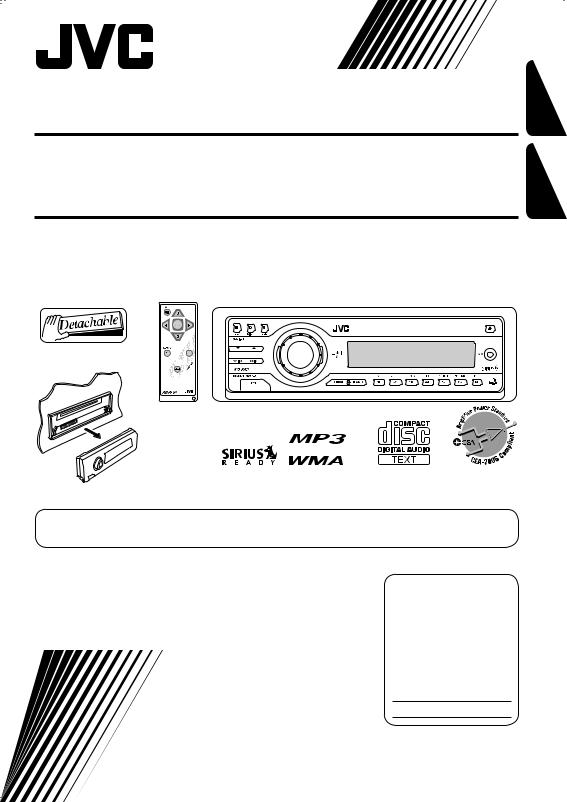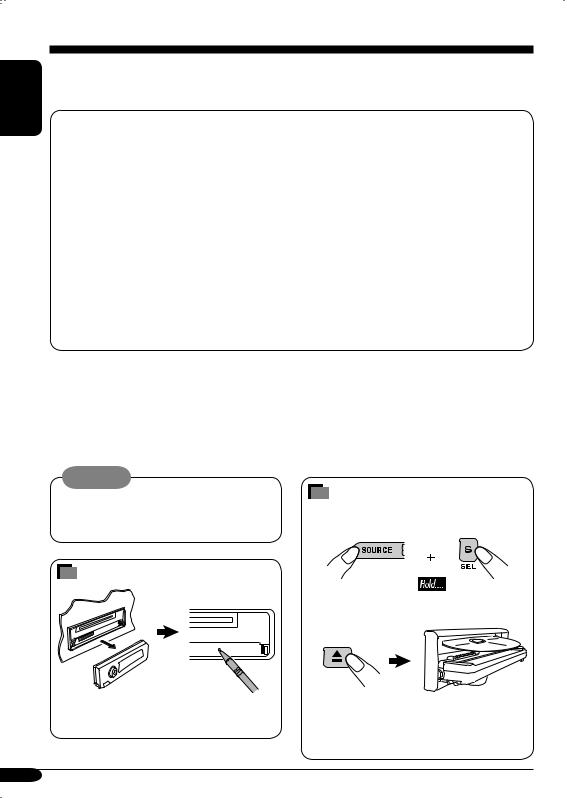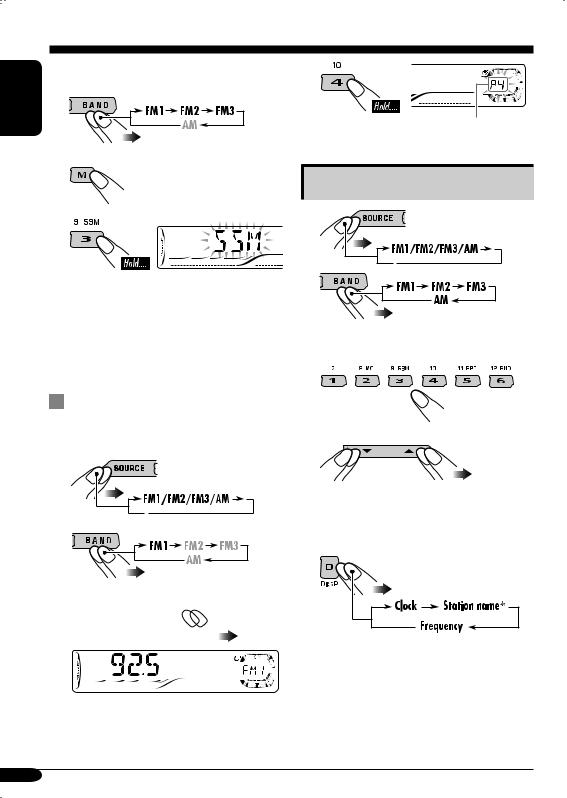JVC KD-S52 User Manual

CD RECEIVER
RECEPTOR CON CD
KD-S52
KD-S52
ESPAÑOL ENGLISH
For canceling the display demonstration, see page 8.
Para cancelar la demostración en pantalla, consulte la página 8.
For installation and connections, refer to the separate manual. Para la instalación y las conexiones, refiérase al manual separado.
INSTRUCTIONS
MANUAL DE INSTRUCCIONES
For customer Use:
Enter below the Model No. and Serial No. which are located on the top or bottom of the cabinet. Retain this information for future reference.
Model No.
Serial No.
GET0322-001A
[J]

ENGLISH
Thank you for purchasing a JVC product.
Please read all instructions carefully before operation, to ensure your complete understanding and to obtain the best possible performance from the unit.
INFORMATION (For U.S.A.)
This equipment has been tested and found to comply with the limits for a Class B digital device, pursuant to Part 15 of the FCC Rules. These limits are designed to provide reasonable protection against harmful interference in a residential installation. This equipment generates, uses, and can radiate radio frequency energy and, if not installed and used in accordance with the instructions, may cause harmful interference to radio communications. However, there is no guarantee that interference will not occur in a particular installation. If this equipment does cause harmful interference to radio or television reception, which can be determined by turning the equipment off and on, the user is encouraged to try to correct the interference by one or more of the following measures:
–Reorient or relocate the receiving antenna.
–Increase the separation between the equipment and unit.
–Connect the equipment into an outlet on a circuit different from that to which the receiver is connected.
–Consult the dealer or an experienced radio/TV technician for help.
IMPORTANT FOR LASER PRODUCTS
1.CLASS 1 LASER PRODUCT
2.CAUTION: Do not open the top cover. There are no user serviceable parts inside the unit; leave all servicing to qualified service personnel.
3.CAUTION: Visible and invisible laser radiation when open and interlock failed or defeated. Avoid direct exposure to beam.
Warning:
If you need to operate the unit while driving, |
How to forcibly eject a disc |
be sure to look ahead carefully or you may |
If a disc cannot be recognized or cannot be |
be involved in a traffic accident. |
ejected, eject the disc as follows. |
How to reset your unit |
|
|
“PLEASE” and “EJECT” appear alternately |
|
on the display. |
•This will reset the microcomputer. Your preset adjustments will also be erased.
•If this does not work, reset your unit.
•Be careful not to drop the disc when it ejects.
2

Contents
How to reset your unit ........................... |
2 |
How to forcibly eject a disc................... |
2 |
How to read this manual........................ |
4 |
How to use the M MODE button........... |
4 |
How to detach/attach the control |
|
panel................................................... |
4 |
Control panel — KD-S52 ........... |
5 |
Parts identification................................. |
5 |
Remote controller — RM-RK60 ... |
6 |
Main elements and features ................... |
6 |
Getting started....................... |
7 |
Basic operations.................................. |
7 |
Canceling the display demonstrations ... |
8 |
Setting the clock .................................... |
8 |
Radio operations ................... |
9 |
Listening to the radio........................... |
9 |
Storing stations in memory.................... |
9 |
Listening to a preset station ................... |
10 |
Disc operations ...................... |
11 |
Playing a disc in the unit ..................... |
11 |
Playing discs in the CD changer ........... |
12 |
Other main functions ............................. |
13 |
Changing the display information ......... |
14 |
Selecting the playback modes................ |
15 |
Sound adjustments ................ |
16 |
Selecting preset sound modes |
|
(C-EQ: custom equalizer) .................. |
16 |
Adjusting the sound ............................... |
16 |
General settings — PSM ......... |
17 |
Basic procedure ..................................... |
17 |
Other main functions ............. |
20 |
Assigning titles to the sources ............... |
20 |
External component operations... |
21 |
Playing an external component ............ |
21 |
SIRIUS® radio operations............ |
22 |
Listening to the SIRIUS® radio.............. |
23 |
Storing channels in memory .................. |
23 |
Listening to a preset channel ................. |
23 |
Maintenance .......................... |
24 |
More about this unit............... |
25 |
Troubleshooting ..................... |
27 |
Specifications ......................... |
29 |
For safety....
•Do not raise the volume level too much, as this will block outside sounds, making driving dangerous.
•Stop the car before performing any complicated operations.
Temperature inside the car....
If you have parked the car for a long time in hot or cold weather, wait until the temperature in the car becomes normal before operating the unit.
ENGLISH
3

ENGLISH
How to read this manual
The following methods are used to make the explanations simple and easy-to-understand:
•Some related tips and notes are explained in “More about this unit” (see pages 25 and 26).
•Button operations are mainly explained with the illustrations as follows:
Press briefly.
Press repeatedly.
Press either one.
Press and hold until your desired response begins.
Press and hold both buttons at the same time.
How to use the M MODE button
If you press M MODE, the unit goes into functions mode, then the number buttons and 5/∞ buttons work as different function buttons.
Ex.: When number button 2 works as MO (monaural) button.
Time countdown indicator
To use these buttons for their original functions again after pressing M MODE, wait for 5 seconds without pressing any of these buttons until the functions mode is cleared.
•Pressing M MODE again also clears the functions mode.
How to detach/attach the control panel
Detaching....
Attaching....
4

Control panel — KD-S52
Parts identification
Display window
ENGLISH
1 5 (up) / ∞ (down) buttons
2 E EQ (equalizer) button
3 D DISP (display) button
4 S SEL (select) button
5• Control dial
•

 (standby/on attenuator) button 6 Display window
(standby/on attenuator) button 6 Display window
7 Remote sensor
•DO NOT expose the remote sensor to strong light (direct sunlight or artificial
|
lighting). |
8 0 (eject) button |
|
9 |
4/¢ buttons |
p |
(control panel release) button |
q SOURCE button w BAND button e Number buttons
r MO (monaural) button
t SSM (Strong-station Sequential Memory) button
y RPT (repeat) button u RND (random) button i M MODE button
oAUX (auxiliary) input jack
• NOT compatible with digital signals.
Display window
; Disc information indicators—TAG (ID3 Tag), (folder),
(folder), (track/file)
(track/file)
a Main display
sSource display Volume level indicator
d EQ (equalizer) indicator
fSound mode (C-EQ: custom equalizer) indicators—ROCK, CLASSIC, POPS, HIP HOP, JAZZ, USER
•
 also works as the time countdown indicator and level meter during play (see page 18).
also works as the time countdown indicator and level meter during play (see page 18).
g Disc type indicators—WMA, MP3
hTuner reception indicators—ST (stereo), MO (monaural)
jPlayback source indicators—
CH: Lights up only when CD-CH is selected
as the playback source.
DISC: Lights up for the built-in CD player.
kPlayback mode / item indicators— RND (random), (disc), (folder),
(disc), (folder),
RPT (repeat)
l LOUD (loudness) indicator / Tr (track) indicator
5

ENGLISH
Remote controller — RM-RK60
Installing the lithium coin battery |
Main elements and features |
(CR2025) |
•Aim the remote controller directly at the remote sensor on the unit. Make sure there is no obstacle in between.
Warning:
•Do not install any battery other than CR2025 or its equivalent; otherwise, it may explode.
•Store the battery in a place where children cannot reach to avoid risk of accident.
•To prevent the battery from over-heating, cracking, or starting a fire:
–Do not recharge, short, disassemble, heat the battery, or dispose of it in a fire.
–Do not leave the battery with other metallic materials.
–Do not poke the battery with tweezers or similar tools.
–Wrap the battery with tape and insulate when throwing away or saving it.
Caution:
1

 (standby/on attenuator) button
(standby/on attenuator) button
•Turns the power on if pressed briefly or attenuates the sound when the power is on.
•Turns the power off if pressed and held. 2 SRC (source) button
•Selects the source.
3R (reverse) / F (forward) buttons
•Searches for stations if pressed briefly.
•Fast-forwards or reverses the track if pressed and held.
•Changes the tracks of the disc.
•While listening to the SIRIUS radio:
–Changes the channels if pressed briefly.
–Changes the channels rapidly if pressed
and held. 4 SOUND button
•Selects the sound mode (C-EQ: custom equalizer).
5U (up) / D (down) buttons
•Changes the FM/AM bands with U (up) only.
•Changes the preset stations with D (down) only.
•Changes the folder of the MP3/WMA discs.
•While playing an MP3 disc on an MP3-compatible CD changer:
–Changes the disc if pressed briefly.
–Changes the folder if pressed and held.
•While listening to the SIRIUS radio:
–Changes the categories.
6VOLUME +/– buttons
• Adjusts the volume level.
6

Getting started
Basic operations |
⁄ Adjust the volume. |
~ 
Ÿ 




You cannot select some sources if they are not ready.
Volume level appears.
Volume level indicator
@Adjust the sound as you want. (See page 16.)
To drop the volume in a moment (ATT)
To restore the sound, press it again.
! • For FM/AM tuner
To turn off the power
• For SIRIUS® radio
ENGLISH
*Select “CD-CH” when using an Apple iPod® or a JVC D. player (see page 21).
iPod is a registered trademark of Apple Computer, Inc.
Caution on volume setting:
Discs produce very little noise compared with other sources. Lower the volume before playing a disc to avoid damaging the speakers by the sudden increase of the output level.
7

ENGLISH
Canceling the display demonstrations
If no operations are done for about 20 seconds, display demonstration starts.
[Initial: DEMO ON]—see page 17.
1
2





3
4 Finish the procedure.
To activate the display demonstration
In step 3 above...
Setting the clock
1
2Set the hour and minute.
1 Select “CLOCK H” (hour), then adjust the hour.
2Select “CLOCK M” (minute), then adjust the minute.
3 Finish the procedure.
To check the current clock time when the power is turned off
8

Radio operations
Listening to the radio
~
Ÿ 
2 Select the desired station frequencies.
When an FM stereo broadcast is hard to receive
1
2
Selected band appears.
Lights up when receiving an FM stereo broadcast with sufficient signal strength.
!Start searching for a station.
When a station is received, searching stops.
To stop searching, press the same button again.
Lights up when monaural mode is activated.
Reception improves, but stereo effect will be lost.
To restore the stereo effect, repeat the same procedure. “MONO OFF” appears and the MO indicator goes off.
Storing stations in memory
You can preset six stations for each band.
To tune in to a station manually
In step ! above...
1
 FM station automatic presetting— SSM (Strong-station Sequential Memory)
FM station automatic presetting— SSM (Strong-station Sequential Memory)
1 |
ENGLISH
To be continued....
9

ENGLISH
2 Select the FM band (FM1 – FM3) |
4 |
you want to store into.
Preset number flashes for a while.
3 

Listening to a preset station
4 |
|
1 |
|
|
|
|
“SSM” flashes, then disappears when |
2 |
|
|
|
|
automatic presetting is over. |
|
Local FM stations with the strongest signals are |
3 Select the preset station (1 – 6) you |
|
searched and stored automatically in the FM |
||
band. |
want. |
|
Manual presetting |
|
|
Ex.: Storing FM station of 92.5 MHz into the |
or |
|
preset number 4 of the FM1 band. |
||
|
1 |
2 |
3 





To check the current clock time while listening to an FM or AM station
* If no title is assigned to a station,
“NO NAME” appears. To assign a title to a station, see page 20.
10
